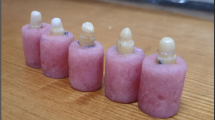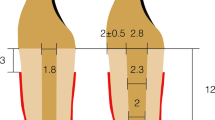Abstract
Objectives
The aim of this study was to evaluate the effect of post system and length on the fracture resistance of endodontically treated human anterior teeth.
Material and method
Seventy-five extracted human incisors were endodontically treated, out of which 60 were decoronated 2 mm above the cementoenamel junction and divided into two experimental groups based on the type of post system to be used: glass fiber post (GFP) and Ribbond fiber post groups (RFP). Endodontically treated human anterior teeth in which no post was placed served as control group. Each group was divided into two subgroups according to the length of post space: 5 and 10 mm and all the samples were restored with metal crowns. The fracture resistance was measured by applying loads at an angle of 130° to the long axis of teeth in an Instron universal testing machine.
Results
The results revealed that GFP group at 10-mm post space length showed the significantly highest fracture resistance (740.2133 N) among all groups and subgroups. Decrease in post length resulted in the decrease in fracture resistance in GFP group (425.1867 N), whereas in group RFP 5-mm subgroup (299.6200 N) showed significantly higher fracture resistance than 10-mm subgroup (216.9300 N) but lesser than the control (437.8733 N) in both the subgroups.
Conclusion
Glass fiber posts efficiently increase the fracture resistance of an endodontically treated tooth but the determination of optimal post length is also essential.
Clinical relevance
The present investigation highlights the significance of using glass fiber posts in the restoration of endodontically treated teeth. Endodontically treated teeth restored with glass fiber posts showed increased fracture strength and favorable mode of fracture, and are therefore highly recommended to achieve better clinical outcomes.




Similar content being viewed by others
Reference
Caputo AA, Standlee JP (1976) Pins and posts why, when and how? Dent Clin N Am 20:299–331
Sorenson JA, Martinoff JT (1984) Clinically significant factors in dowel design. J Prosthet Dent 52:28–35
Rosen H (1982) Cracked tooth syndrome. J Prosthet Dent 47:36–43
Trope M, Maltz DO, Tronstad L (1985) Resistance to fracture of restored endodontically treated teeth. Endod Dent Traumatol 1:108
Lynch CD, Burke FM (2002) Incomplete tooth fracture following root-canal treatment: a case report. Int Endod J 35:642–0646
Rivera E, Yamauchi G, Chandler G, Bergenholtz G (1988) Dentin collagen cross-links of root-filled and normal teeth. J Endod 14:195
Helfer AR, Melnick S, Schilder H (1972) Determination of moisture content of vital and pulpless teeth. Oral Surg Oral Med Oral Pathol 34:661–670
Gutmann JL (1992) The dentin–root complex: anatomic and biologic considerations in restoring endodontically treated teeth. J Prosthet Dent 67:458–467
Standlee JP, Caputo AA, Hanson EC (1978) Retention of endodontic dowels: effects of cement, dowel length, diameter, and design. J Prosthet Dent 39:401
Shillingburg HT, Hobo S, Whitsett LD, Jacobi R, Brackett SE (1997) Preparations for extensively damaged teeth. In: Shillingburg HT, Hobo S, Whitsett LD, Jacobi R, Brackett SE (eds) Fundamentals of fixed prosthodontics. Quintessence, Chicago, pp 181–209
Tjan AH, Grant BE, Dungn JR (1991) Microleakage of composite resin cores treated with various dentin bonding systems. J Prosthet Dent 66:24–29
Yang HS, Lang LA, Molina A, Felton DA (2001) The effects of dowel design and load direction on dowel-and-core restorations. J Prosthet Dent 85:558–567
Tay FR (2007) Monoblocks in root canals: a hypothetical or a tangible goal. J Endod 33:391–396
Standlee JP, Caputo AA, Collard EW, Pollack MH (1972) Analysis of stress distribution by endodontic posts. Oral Surg Oral Med Oral Pathol 33:952–960
King PA, Setchell DJ (1990) An in vitro evaluation of a prototype CFRC prefabricated post developed for the restoration of pulpless teeth. J Oral Rehabil 17:599–609
Purton DG, Love RM (1996) Rigidity and retention of carbon fiber versus stainless steel root canal posts. Int Endod J 29:262–265
Fernandes AS, Dessai GS (2001) Factors affecting the fracture resistance of post-core reconstructed teeth: a review. Int J Prosthodont 14:355–363
Nissan J, Dmitry Y, Assif D (2001) the use of reinforced composite resin cement as compensation for reduced post length. J Prosthet Dent 86:304–308
Sokol DJ (1984) Elective use of current core post concepts. J Prosthet Dent 52:231–234
Standlee JP, Caputo AA, Holcomb J, Trabert KC (1980) The retentive and stress distributing properties of a threaded endodontic dowel. J Prosthet Dent 44:398–404
Lovdahl PE, Nicholls JI (1979) Pin-retained amalgam cores vs. cast-gold dowel-cores. J Prosthet Dent 43:307–312
Reagan SE, Fruits TJ, Van Brunt CL, Ward CK (1999) Effects of cyclic loading on selected post-and-core systems. Quintessence Int 30:61–67
Sirimai S, Riis DN, Sm M (1999) An in-vitro study of the fracture resistance and the incidence of vertical root fracture of pulpless teeth restored with six post-and-core systems. J Prosthet Dent 81:262–269
Heydecke G, Butz F, Strub JR (1999) The effect of various post/core buildup designs on the fracture resistance of crown restored incisors. Dtsch Zahnarztl Z 54:637–640
Isidor F, Brøndum K (1992) Intermittent loading of teeth with tapered, individually cast or prefabricated, parallel-sided posts. Int J Prosthodont 5:257–261
Isidor F, Brøndum K, Ravnholt G (1999) The influence of post length and crown ferrule length on the resistance to cyclic loading of bovine teeth with prefabricated titanium posts. Int J Prosthodont 12:78–82
Santos-Filho PC, Castro CG, Silva GR, Campos RE, Soares CJ (2008) Effects of post system and length on the strain and fracture resistance of root filled bovine teeth. Int Endod J 41:493–501
Lauer H-C, Ottl P, Weigl P (1994) Mechanical resistance of different post-and-core systems [in German with English summary]. Dtsch Zahnarztl Z 49:985–989
Schmeissner H (1983) Comparison of the fracture loads of smooth and screw retained post and core reconstructions [in German with English summary]. Dtsch Zahnarztl Z 38:163–166
Butz F, Lennon AM, Heydecke G, Strub JR (2001) Survival rate and fracture strength of endodontically treated maxillary incisors with moderate defects restored with different post and core systems. An in-vitro study. Int J Prosthodont 14:58–64
Mendoza DB, Eakle WS, Kahl EA, Ho R (1997) Root reinforcement with a resin-bonded preformed post. J Prosthet Dent 78:10–14
O’Keefe KL, Miller BH, Powers JM (2000) In vitro tensile bond strength of adhesive cements to new post materials. Int J Prosthodont 13:47–53
Eakle WS, Staninec M, Lacy AM (1992) Effect of bonded amalgam on the fracture resistance of teeth. J Prosthet Dent 68:257–260
Suh B, Cincione F (1992) All-Bond 2: the fourth generation bonding system. Esthet Dent Update 3:61–66
Leinfelder KF (1993) Current developments in dentin bonding systems: major progress found in today's products. Oral Health 8:7–8
Junge T, Nicholls JI, Phillips KM, Libman WK (1998) Load fatigue of compromised teeth: a comparison of three luting cements. Int J Prosthodont 11:558–564
Guzy GE, Nicholls JI (1979) In vitro comparison of intact endodontically treated teeth with and without endo-post reinforcement. J Prosthet Dent 42:39
Soares CJ, Pizi EC, Fonseca RB, Martins LR (2005) Influence of root embedment material and periodontal ligament simulation on fracture resistance tests. Pesquisa Odontolo´gica Brasileira 19, 11–6. In vitro study. Swed Dent J 7:205–214
Newman MP, Yaman P, Dennison J, Rafter M, Billy E (2003) Fracture resistance of endodontically treated teeth restored with composite posts. J Prosthet Dent 89:360–367
Martelli H Jr, Pellizzer EP, Rosa BT, Lopes MB, Gonini A Jr (2008) Fracture resistance of structurally compromised root filled bovine teeth restored with accessory glass fiber posts. Int Endod J 41:685–692
Hayashi M, Takahashi Y, Imazato S, Ebisu S (2005) Fracture resistance of pulpless teeth restored with post-cores and crowns. Dent Mater 16:17–21
Loney RW, Korowicz WE, McDowell GC (1990) Three-dimensional photoelastic stress analysis of the ferrule effect in cast post and cores. J Prosthet Dent 63:506–512
EshelmanJr EG, Sayegh FS (1983) Dowel materials and root fracture. J Prosthet Dent 50:342–344
Patel A, Gutteridge DL (1996) An in vitro investigation of cast post and partial core design. J Dent 24:281–287
Zarone F, Sorrentino R, Apicella D et al (2006) Evaluation of the biomechanical behaviour of maxillary central incisors restored by means of endocrowns compared to a natural tooth: a 3D static linear finite elements analysis. Dent Mater 22:1035–1044
Giovani AR, Vansan LP, de Sousa Neto MD, Paulino SM (2009) In vitro fracture resistance of glass-fiber and cast metal posts with different lengths. J Prosthet Dent 101:183–188
Shillingburg HT, Kessler JC, Wilson EL (1982) Root dimensions and dowel size. Calif Dent Assoc J 10:43
Mannocci F, Ferrari M, Watson TF (1999) Intermittent loading of teeth restored using quartz fiber, carbon-quartz fiber, and zirconium dioxide ceramic root canal posts. J Adhes Dent 1:153–158
Akkayan B, Gulmez T (2002) Resistance to fracture of endodontically treated teeth restored with different post systems. J Prosthet Dent 87:431–437
Naumann M, Blankenstein F, Dietrich T (2005) Survival of glass fiber reinforced composite post restorations after 2 years—an observational clinical study. J Dent 33:305–312
Conflict of interest
The authors declare that they have no conflict of interest.
Author information
Authors and Affiliations
Corresponding author
Rights and permissions
About this article
Cite this article
Jindal, S., Jindal, R., Mahajan, S. et al. In vitro evaluation of the effect of post system and length on the fracture resistance of endodontically treated human anterior teeth. Clin Oral Invest 16, 1627–1633 (2012). https://doi.org/10.1007/s00784-012-0673-9
Received:
Accepted:
Published:
Issue Date:
DOI: https://doi.org/10.1007/s00784-012-0673-9




